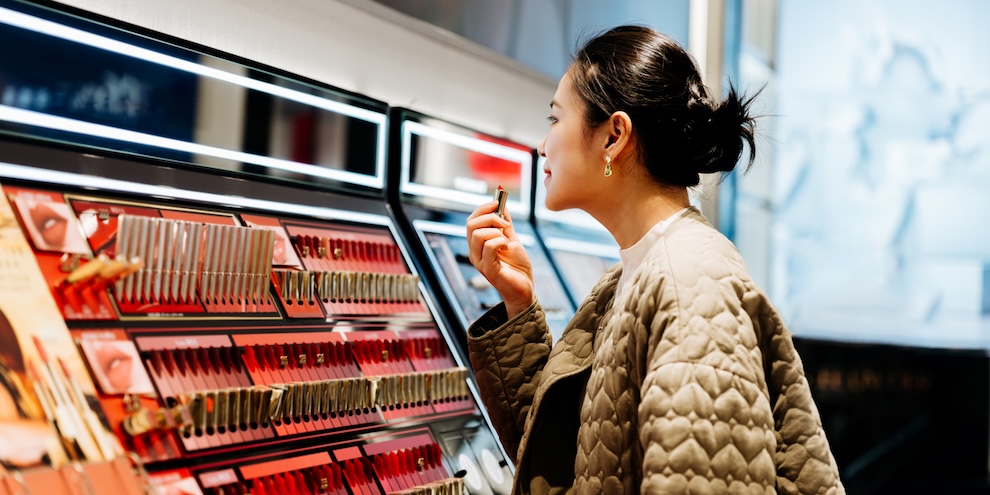The benefits and challenges of store-within-a-store partnerships
Editor’s note: Lanie Beck is the senior director of content and marketing research at Northmarq. This is an edited version of an article that originally appeared under the title “Two Brands, One Roof: The Rise of Store-Within-a-Store Retail Partnerships.”
A growing phenomenon in brick-and-mortar retail is the store-within-a-store (SWAS), or shop-within-a-shop, business model where one retailer leases a section of its floor space to another retailer. Case in point: The ongoing strategic partnership between Target and Ulta Beauty since 2020, in which the latter operates "mini-shops" within select locations of the former.
The store-within-a-store concept isn't new. Department stores like Marshall Field's in Chicago and Harrods in London allowed select brands to set up shop within their locations from the early 20th century. However, the trend is becoming increasingly commonplace across the retail industry due to competition from e-commerce retailers and ever-changing consumer habits.
What are the benefits of store-within-a-store concepts?
Industry research into the store-within-a-store concept has been scarce. However, we can observe the following benefits for retail landlords, brands and consumers:
The benefits for retail landlords:
- SWAS can increase foot traffic and revenue streams for the primary retailer (or landlord), allowing them to capitalize on another retailer's name and customer base.
- The SWAS concept enables a landlord to differentiate itself from competitors by offering a brand partnership that utilizes a second retailer's reputation and target audience.
The benefits for brands:
- Brands benefit from the SWAS model by getting their products in front of another retailer's already established customer base.
- The store-within-a-store may offer a lower investment risk for brands than setting up standalone stores, especially if the primary retailer already has high foot traffic and a strong reputation.
The benefits for consumers:
- The SWAS concept offers a more convenient shopping experience because consumers can visit two retailers in the same physical space, saving them time and effort.
- This unique retail experience can't be replicated online, allowing consumers to browse and purchase products in a single real-world location.
The challenges and considerations of store-within-a-store concepts
Friction can exist between landlords and brands, especially regarding rent, control over customer data and product display rules. Because of this, many SWAS collaborations have experienced challenges. Take Target and Starbucks, for example. In the early days, the latter struggled to integrate with the former's customer flow and store layout. However, the retailers have since realigned their goals, resulting in a more successful partnership.
Constant innovation is critical for both primary and secondary retailers to keep the SWAS concept fresh and engaging. This may involve a brand offering exclusive products in a landlord's store or incentivizing consumers to visit a SWAS space. For example, Target Circle members can earn perks and reward points by shopping at an Ulta Beauty located within a Target store.
Examples of successful store-within-a-store concepts
Here are 10 examples that showcase the benefits of the store-within-a-store model.
1. Sephora in Kohl's

Kohl's and Sephora announced a strategic partnership in 2020, promising to combine the former's "expansive customer reach and omnichannel convenience" with the latter's "prestige service, product selection and exceptional beauty experience."
Why does this partnership work?
This partnership has been a game-changer for both brands:
- Expanded customer base: Sephora gains access to Kohl's suburban shoppers, while Kohl's attracts younger, beauty-focused customers who might not otherwise visit.
- Enhanced shopping experience: Dedicated Sephora spaces within Kohl's stores offer a premium, hands-on beauty experience, including product sampling and expert consultations.
- Mutual benefits: Kohl's benefits from increased foot traffic and sales, while Sephora strengthens its physical retail presence in suburban areas where standalone stores are less common.
The key takeaway: Aligning complementary customer bases and creating a premium experience within a value-driven retailer can drive success.
2. Ulta Beauty in Target
As mentioned above, Target and Ulta Beauty have worked together since 2020, with this store-within-a-store concept offering curated beauty brands and expert-trained consultants.
Why does this partnership work?
Similar to Sephora in Kohl's, this partnership has been a win-win:
- Shared demographics: Both brands target young, diverse Gen Z shoppers who value convenience and curated beauty products.
- Seamless integration: Ulta's mini stores within Target offer a handpicked selection of products, loyalty program integration and exclusive deals, enhancing the shopping experience.
- Increased foot traffic: Target benefits from Ulta's loyal customer base, while Ulta gains exposure to Target's massive audience.
The key takeaway: Leveraging shared customer demographics and integrating loyalty programs can create a seamless and mutually beneficial partnership.
3. Disney in Target
Disney and Target teamed up in 2019. The collaboration, which launched with 25 Disney stores in select Target stores, encompasses experiential retail and merchandising, according to a press release at the time.
Why does this partnership work?
Disney's mini stores in Target locations have been a hit for the following reasons:
- Exclusive merchandise: Disney offers exclusive products, like the recent Pillowfort collection, that appeal to Target's family-oriented shoppers.
- Immersive experience: Disney's mini stores create a magical shopping experience with themed displays and interactive elements.
- Convenience: Parents can shop for Disney products while completing their regular Target runs, saving time and effort.
The key takeaway: Creating an immersive, branded experience within a high-traffic retailer can attract loyal customers and enhance the overall shopping journey.
4. Nike in DICK'S Sporting Goods
Established in 2021, the Nike-DICK'S "connected partnership" offers access to exclusive products, experiences and content.
Why does this partnership work?
- Shared audience: Both brands target sports enthusiasts and athletes, making the partnership a natural fit.
- Curated experience: Nike-branded sections in DICK'S stores offer a premium shopping experience, with exclusive products and interactive features like shoe customization.
- Increased foot traffic: Nike's strong brand loyalty (ranked ninth in the world for all brands) draws customers to DICK'S, while DICK'S provides Nike with a broader retail footprint.
They key takeaway: Partnerships that enhance the shopping experience and align with customer interests can drive mutual success.
5. Apple in Best Buy
Best Buy became one of Apple's authorized repair partners in 2019, with nearly 1,000 Best Buy stores providing expert service for Apple products.
Why does this partnership work?
- Brand synergy: Best Buy's focus on technology and electronics complements Apple's premium product line.
- Nationwide reach: Apple benefits from Best Buy's extensive retail network, reaching customers in areas without Apple Stores.
The key takeaway: Offering a premium, hands-on repair experience in a complementary retail environment can boost sales and brand visibility. A strong alignment in customer expectations can drive long-term success.
6. Starbucks in Barnes & Noble

The Starbucks-Barnes & Noble partnership dates back to the '90s, when the bookstore wanted to bring "more community to its doors," according to a recent article.
Why does this partnership work?
- Enhanced atmosphere: Starbucks cafes create a cozy, inviting environment that encourages customers to linger and browse books.
- Mutual benefits: Barnes & Noble stores potentially benefit from increased foot traffic and longer customer dwell times, while Starbucks gains access to Barnes & Noble's predominately young, female and coffee-drinking demographic.
The key takeaway: Partnerships that enhance the overall customer experience and align with lifestyle preferences can create lasting success.
7. Levi's in Macy's
Levi's teamed up with Macy's in 2017 for a clothing collection, and the partnership has since evolved, benefiting both brands.
Why does this partnership work?
- Brand heritage: Levi's iconic denim fits seamlessly into Macy's focus on classic, high-quality apparel.
- Dedicated spaces: Levi's sections in Macy's stores showcase a wide range of products, from jeans to jackets, in a branded environment.
- Increased exposure: Macy's provides Levi's with access to a broad, fashion-conscious customer base.
The key takeaway: Leveraging a host retailer's established customer base and creating a branded in-store presence can drive sales and brand loyalty.
8. Claire's in Macy's
Select Macy's locations now offer jewelry, cosmetics, hair accessories and other products from Claire's as a result of an exclusive brand partnership established in 2022.
Why does this partnership work?
- Retail footprint diversification: Claire's diversifies its retail footprint, allowing the brand to target more customers.
- Fills physical retail space: Shop-in-shop experiences like this one help Macy's fill space left by departments that have closed in recent years.
- Product expansion: Thanks to this partnership, Macy's can expand its offerings of jewelry and other accessories.
The key takeaway: By expanding product offerings and filling retail space for a landlord, store-within-a-store concepts can be highly effective.
9. Five Beyond in Five Below
In 2023, Five Below introduced a new section in its stores called Five Beyond that offers products priced at $6 or more.
Why does this work?
- Appeals to a broader customer base: By offering products that are more than Five Below's five-dollar limit, the Five Beyond section attracts a wider range of customers, including those who may not normally visit Five Below stores.
- Offers premium products: A more expensive product range increases Five Below's offerings, resulting in more sales.
- Maintains brand identity: Five Below and Five Beyond have similar names and branding, helping Five Below maintain its brand identity.
The key takeaway: Integrating a premium brand or product range into a discount retailer can appeal to more consumers and potentially drive revenue.
10. Warby Parker in Target (unproven but promising)
Warby Parker's mini stores in five Target locations, established in 2025, bring "designer-quality, affordable eyewear to even more consumers," according to a press release announcing the collaboration.
Why it could work
This partnership is still in its early stages but shows strong potential:
- Target's strength: Target's high foot traffic and reputation for offering trendy, affordable products make it an ideal host for Warby Parker.
- Warby Parker's appeal: Warby Parker brings a niche, direct-to-consumer brand into a mainstream retail environment, potentially reaching new customers who value convenience.
The key takeaway: If executed well, this partnership could bridge the gap between niche and mainstream retail, offering convenience and style to a broader audience.
Unsuccessful store-within-a-store concepts
Here are five SWAS partnerships that didn't quite hit the mark.
1. McDonald's in Walmart
Why did this partnership fail?
McDonald's and Walmart had a long-standing partnership with over 800 locations in 2012, but by 2021, this number had dwindled to just 150 or fewer. The primary reasons for the decline included:
- A shift in consumer behavior: During the pandemic, 70% of McDonald's sales came from drive-thrus, a feature not viable in Walmart locations.
- Walmart's strategic shift: Walmart remodeled its supercenters to focus on digital shopping experiences, making McDonald's less relevant to its new vision.
The key takeaway: Partnerships must evolve with changing consumer preferences and operational needs. McDonald's reliance on dine-in traffic clashed with Walmart's push for digital and delivery-focused services.
2. Target and Neiman Marcus
Why did this partnership fail?
A 2012 holiday collaboration aimed to merge Target's affordability with Neiman Marcus's luxury appeal. However, it struggled due to:
- Mismatched customer bases: Target's value-focused shoppers found the luxury items too expensive, while Neiman Marcus's clientele didn't see the appeal of shopping at Target.
- Poor sales performance: The collection was heavily discounted shortly after launch, signaling a lack of demand.
The key takeaway: Successful partnerships require alignment in brand identity and customer expectations. A mismatch can alienate both audiences.
3. The early days of Starbucks in Target
Why did this partnership struggle initially?
While now a successful partnership, Starbucks faced challenges in its early days within Target:
- Operational misalignment: Starbucks struggled to integrate with Target's customer flow and store layout.
- Limited awareness: Many customers initially didn't associate Starbucks with Target, reducing foot traffic to the in-store cafes.
The key takeaway: Even strong brands need time and strategic adjustments to make partnerships work. Starbucks eventually succeeded by improving visibility and aligning with Target's shopper experience.
4. RadioShack in Sprint Stores
Why did this partnership fail?
The partnership, launched in 2015 as part of RadioShack's bankruptcy restructuring, aimed to co-brand stores and sell Sprint's wireless products alongside RadioShack's electronics. However, it collapsed due to several key issues:
- Revenue shortfall: The partnership failed to generate the anticipated revenue from wireless product sales. Sprint's mobility sales dropped significantly in late 2016, leaving RadioShack without the commissions it had expected.
- Operational conflicts: Sprint began pulling its wireless displays from RadioShack stores, signaling a breakdown in the relationship. This disrupted the co-branded store model and left RadioShack scrambling to fill the void.
- Legal and trust issues: RadioShack's creditors accused Sprint of using confidential information from the partnership to open competing stores, further straining the relationship.
- Market challenges: RadioShack was already struggling to compete with online retailers like Amazon and changing consumer habits. The partnership with Sprint did little to address these broader challenges.
The final outcome
RadioShack filed for bankruptcy again in 2017. Sprint paid $12 million to wind down the relationship and took over leases for 115 stores.
The key takeaway: A store-within-a-store concept should be used when there's mutual trust and benefits for both parties. The entire arrangement can unravel when one party fails to meet obligations or when market conditions shift.
5. Toys "R" Us in Macy's
Why does this partnership face challenges?
The partnership, launched in 2021, aims to bring Toys "R" Us-branded shop-in-shops to over 400 Macy's locations. While it has potential, several challenges have emerged:
- Space constraints: Toys "R" Us was historically known for its massive stores with extensive inventory. Translating this experience into the smaller, more limited spaces within Macy's stores risks diluting the brand's identity.
- Competition from giants: Macy's and Toys "R" Us must compete with dominant players like Amazon, Walmart and Target, which already control the majority of the toy market. These competitors offer lower prices, broader selections and faster delivery.
- Brand perception: Toys "R" Us is attempting to rebuild its reputation after its 2018 liquidation and subsequent failed relaunches. Some consumers may associate the brand with its decline, which could hinder its ability to attract loyal customers.
- Operational complexity: Macy's owns the inventory and manages merchandising, while Toys "R" Us guides trends. This division of responsibilities could lead to inefficiencies or misaligned strategies.
- Missed opportunities: The rollout missed the 2021 holiday season, a critical time for toy sales, leaving money on the table and delaying the partnership's impact.
The outcome so far
Macy's CEO has expressed optimism, predicting that the partnership could quintuple Macy's toy sales. However, the success of the initiative depends on how well the two brands can differentiate their offerings and create a compelling in-store experience.
The key takeaway: Reviving a legacy brand within a new retail format requires careful execution. Without a strong, differentiated value proposition, the partnership risks being overshadowed by more established competitors.
A look forward: The future of retail partnerships

The store-within-a-store concept is a growing trend because of its ability to generate revenue and foot traffic, align customer bases and enhance the consumer experience.
Despite many success stories, not all SWAS partnerships work. Retailers must align their visions and execute their strategies cautiously to benefit everyone. One thing's for sure: Store-within-a-store will continue to have a place in the future of retail, allowing retailers to capitalize on each other's strengths.
